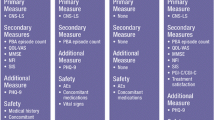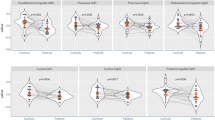Abstract
Pseudobulbar affect (PBA) is defined as episodes of involuntary crying, laughing, or both in the absence of a matching subjective mood state. This neuropsychiatric syndrome can be found in a number of neurological disorders including multiple sclerosis (MS). The aim of this study was to identify neuroanatomical correlates of PBA in multiple sclerosis (MS) using a case-control 1.5T MRI study. MS patients with (n = 14) and without (n = 14) PBA were matched on demographic, disease course, and disability variables. Comorbid psychiatric disorders including depressive and anxiety disorders were absent. Hypo- and hyperintense lesion volumes plus measurements of atrophy were obtained and localized anatomically according to parcellated brain regions. Between-group statistical comparisons were undertaken with α set at 0.01 for the primary analysis. Discrete differences in lesion volume were noted in six regions: Brainstem hypointense lesions, bilateral inferior parietal and medial inferior frontal hyperintense lesions, and right medial superior frontal hyperintense lesions were all significantly higher in the PBA group. A logistic regression model identified four of these variables (brainstem hypointense, left inferior parietal hyperintense, and left and right medial inferior frontal hyperintense lesion volumes) that accounted for 70% of the variance when it came to explaining the presence of PBA. In conclusion, MS patients with PBA have a distinct distribution of brain lesions when compared to a matched MS sample without PBA. The lesion data support a widely-dispersed neural network involving frontal, parietal, and brainstem regions in the pathophysiology of PBA.
Similar content being viewed by others
References
Arciniegas DB, Topkoff J (2000) The neuropsychiatry of pathologic affect: an approach to evaluation and treatment. Sem Clin Neuropsychiatry 5:290–306
Ashburner J, Friston KJ (2000) Voxelbased morphometry–The methods. NeuroImage 11:805–821
Bermel RA, Bakshi R (2006) The measurement and clinical relevance of brain atrophy in multiple sclerosis. Lancet Neurol 5:158–170
Black DW (1982) Pathological laughter: a review of the literature. J Nerv Ment Dis 170:67–71
Bokde AL, Teipel SJ, Zebuhr Y, Leinsinger G, Gootjes L, Schwarz R, Buerger K, Scheltens P, Moeller HJ, Hampel H (2002) A new rapid landmark-based regional MRI segmentation method of the brain. J Neurol Sci 194:35–40
Caviness VS Jr, Meyer J, Makris N, Kennedy DN (1996) MRI-based topographic parcellation of human neocortex: an anatomically specified method with estimate of reliability. J Cogn Neurosci 8:566–587
Dade LA, Gao FQ, Kovacevic N, et al. (2004) Semi-automatic brain region extraction: A method of parcellating brain regions from structural magnetic resonance images. Neuroimage 22:1492–1502
Eastwood MR, Rifat SL, Nobbs H, Ruderman J (1989) Mood disorders following cerebral vascular accident. Br J Psychiatry 154:195–200
Feinstein A, Feinstein KJ, Gray T, O'Connor P (1997) The prevalence and neurobehavioral correlates of pathological laughter and crying in multiple sclerosis. Arch Neurol 54:1116–1121
Feinstein A, O'Connor P, Gray T, Feinstein K (1999) Pathological laughing and crying in multiple sclerosis: a preliminary report suggesting a role for the prefrontal cortex. Mult Scler 5:69–73
Feinstein A, Roy P, Lobaugh N, et al. (2004) Structural brain abnormalities in multiple sclerosis patients with major depression. Neurology 62:586–590
Harrell FE Jr. (2001) Regression modeling strategies. New York: Springer
Hosmer DW, Lemeshow S (1989) Applied logistic regression.New York: John Wiley and Sons
House A, Dennis M, Molyneux C, Hawton K (1989) Emotionalism after stroke. Brit Med J 298:991–994
Kosaka H, Omata N, Omori M, Shimoyama T, Murata T, Kashikura K, Takahashi T, Murayama J, Yonekura Y, Wada Y (2006) Abnormal pontine activation in pathological laughing as shown by functional magnetic resonance imaging. J Neurol Neurosurg Psychiatry 77:1376–1380
Kovaceric N, Lobaugh NJ, Bronskill MJ, et al. (2002) A robust method for extraction and automatic segmentation of brain images. Neuroimage 17:1087–1100
Langworthy OR, Hesser FH (1940) Syndrome of pseudobulbar palsy: an anatomic and physiologic analysis. Arch Int Med 65:106–121
McCullagh S, Moore M, Gawel M, Feinstein A (1999) Pathological laughing and crying in amyotrophic lateral sclerosis. An association with prefrontal cognitive dysfunction. J Neurol Sci 169:43–48
McDonald WI, Miller DH, Thompson A (1994) Are magnetic resonance findings predictive of clinical outcome in therapeutic trials in multiple sclerosis? The dilemma of interferon-β. Ann Neurol 36:14–18
Mega MS, Cummings JL, Salloway S, et al. (1997) The limbic system: an anatomic, phylogenetic and clinical perspective. In: S Salloway, Malloy P, Cummings JL (eds) The Neuropsychiatry of Limbic and Subcortical Disorders. Washington DC: American Psychiatric Press
Parvisi J, Andersen SW, Martin CO, et al. (2001) Pathological laughter and crying. A link to the cerebellum. Brain 124:1708–1719
Poeck K (1969) Pathophysiology of emotional disorders associated with brain damage. In: PJ Vinken, GW Bruyn GW (eds) Handbook of Clinical Neurology (vol. 3). Amsterdam: North Holland Publishing Company, pp 343–367
Polman CH, Reingold SC, Edan G, et al. (2005) Diagnostic criteria for multiple sclerosis: 2005 revisions to the "McDonald Criteria". Ann Neurol 58:840–684
Quarantelli M, Larobina M, Volpe U, Amati G, Tedeschi E, Ciarmiello A, Brunetti A, Galderisi S, Alfano B (2002) Stereotaxy-based regional brain volumetry applied to segmented MRI: validation and results in deficit and nondeficit schizophrenia. NeuroImage 17:373–384
Rudick RA, Fisher E, Lee JC, et al. (1999) Use of the brain parenchymal fraction to measure whole brain atrophy in relapsing remitting MS. Multiple sclerosis collaborative research group. Neurology 53:1698–1704
Sackheim HA, Greenberg MS, Weinman AL, et al. (1982) Hemispheric symmetry in the expression of positive and negative emotions. Neurologic evidence. Arch Neurol 39:210–218
Shaibani AT, Sabbagh M, Doody R (1994) Laughter and crying in neurologic disease. Neuropsychiatry Neuropsychol Behav Neurol 7:243–250
Tisserand DJ, Pruessner JC, Sanz Arigita EJ, van Boxtel MP, Evans AC, Jolles J, Uylings HB (2002) Regional frontal cortical volumes decrease differentially in aging: an MRI study to compare volmetric approaches and voxel-based morphometry. Neuro-Image 17:657–669
Wilson SUK (1924) Some problems in neurology. II. Pathological laughing and crying. J Neurol Psychopathol 4:1299–1333
Zivadinov R, Locatelli L, Stival B, et al. (2003) Normalized regional brain atrophy measurements in multiple sclerosis. Neuroradiol 45:793–798
Author information
Authors and Affiliations
Corresponding author
Rights and permissions
About this article
Cite this article
Ghaffar, O., Chamelian, L. & Feinstein, A. Neuroanatomy of pseudobulbar affect. J Neurol 255, 406–412 (2008). https://doi.org/10.1007/s00415-008-0685-1
Received:
Revised:
Accepted:
Published:
Issue Date:
DOI: https://doi.org/10.1007/s00415-008-0685-1




